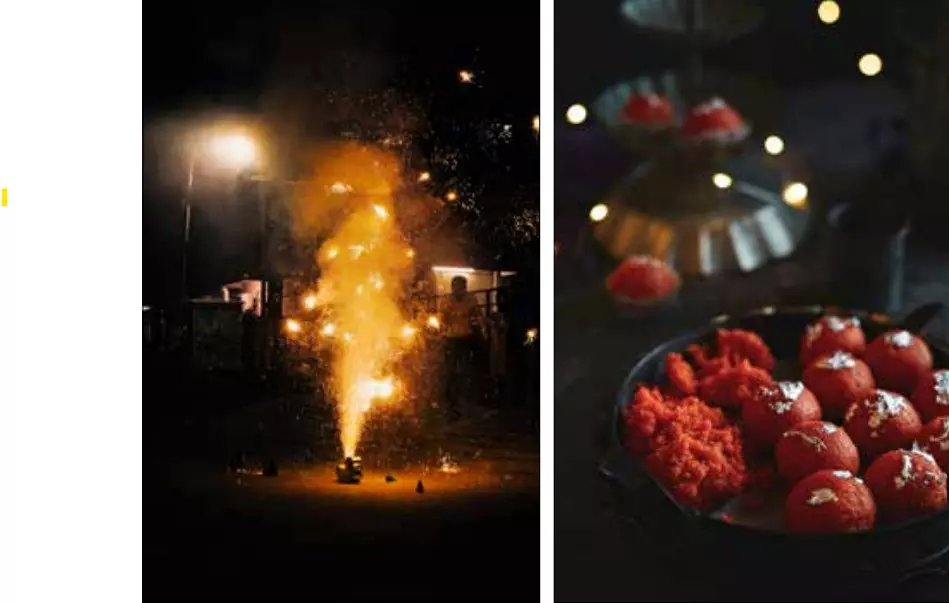Talking Shop: Deadly-Sweet Diwali
A festival of ‘Lights & Mithai’ became a toxic mix of ‘Patakhas & Adulteration’. The backhanded silver lining – Delhi was named the world’s most polluted city

“Chemistry can be both
good and bad. Chemistry
is good when you make
love with it. That same
chemistry is ruinous if
you make drugs with it.”
— Adam Sandler
They live(d) in very different times, did Lord Rama and Adam Sandler. But there is a common vein running through their action and statement; a belief that when good prevails, it reaches a new acme. This is an apex where the teachings that boys and girls are brought up on come true; such as right and wrong, proper and improper, niceties and blemishes, good and evil… Telling the truth is right, lying is wrong. Respecting others is proper, being rude improper. Smiling is a nicety, scowling a blemish. Lord Rama is good, King Ravana evil.
This unpretentious and ingenuous childhood logic-analogy suggests that Kolkata is right, Delhi wrong. Both cities were asked by courts to desist from using firecrackers this Diwali, in a last-ditch, desperate bid to curb air pollution. As expected, the people of Kolkata (in fact, the entire West Bengal) honoured the diktat, while those in Delhi and other North Indian cities (true to form, I may add) thumbed their nose and merrily lit go-kaboom fuses on firecrackers till dogs and humans became friends again, scurrying away hand-on-head from the cacophony, smoke and toxic fumes. This is not a joke – over 1,000 dogs and an equal number of human beings are missing in North India since Diwali.
The festival of ‘Lights & Sweets’ became a toxic mix of ‘Adulteration & Patakhas’ in 2024. Sure, Dilliwallas received a backhanded silver lining, with India’s Capital being named the world’s ‘Most Polluted City’ by Swiss air-monitoring agency IQAir.
Keeling over the day after
On the watchlist of AQI (Air Quality Index) alarms in the weeks leading up to Diwali, Delhi buckled and keeled over the day after the festivities, with AQI being thrice the limit considered safe for breathing. Parts of the Capital were found to have AQIs four times above ‘safe breathing’, leading to respiratory ailments and complications for thousands. Through the night, people coughed and wheezed as fumes entered their impenetrable cocoons. Many celebrating ‘good over evil’ from homes found themselves on the ‘endangered list’ the next day, because they had celebrated the good by eating evil. Literally.
Last week, this column spoke of food adulteration. On Diwali day 2024, this became ‘Breaking News’. Let’s revisit the horror stuff that people ate with relish and abandon. Yes, adulteration has been rising for a while, but this time around, things went overboard, especially in a festive season where more sweets and snoepjes are consumed in a fortnight than through the rest of the year.
Tests found extremes in adulteration, the primary being impurities in 80 per cent of the tested samples of mewa (base mix) used in sweets. Total Diwali sweets sales stood at Rs 1,80,000 crore, the festival triggering a 50-per cent rise in consumption. Look at standalone numbers – 45 kg of spurious sweets were found in a single shop in Noida; 180 kg of rasgullahs with insects and cockroaches were seized in Greater Noida; 300 kg of unclean mewa was found in Ujjain; 225 kg of impure mewa was seized in Indore; 400 kg of mewa was confiscated in Ghaziabad; 1,300 kg of rotten paneer (cottage cheese) was seized in Ghaziabad, with those tasked with throwing it away gagging and fainting from the smell. Paneer pakoda, anyone?
What gives, or doesn’t?
With demand so high, the very real possibility of mithais being made with low-quality flour, fats and oils came true, giving the ‘lucky ones’ an upset stomach, for others suffered deadly food poisoning. In some cases, the contaminants were even worse, given our penchant for glitz and ornamentation. For instance, kaju katli and barfi feature a silver varq (thin cladding) that enhances their appeal. Silver in foods must be 99.9-per cent pure, the norms say, but given the cost of silver, many used aluminium foils, beating them so thin that it looked and gleamed like the real stuff. Aluminium barfi?
Black jest aside, the fact is Diwali, a festival that signifies purity, joy and family, metamorphosed into a health hazard. What should have been a time of indulgence in sweets and celebrations signified a need for caution, with sweets and food items being dangerous to even look at. The glitter of festival lights was overshadowed by the smoke of disregarded health regulations and profiteering practices that put a quick buck over people’s health and well-being.
Today’s reality is that the mithai that symbolizes Diwali – laddoos, barfis, chhena murgi and rasgullahs – is riddled with contaminants. Milk, ghee and basic ingredients like flour are adulterated. Dairy products are mixed with synthetic milk or starch to bulk up quantities, while food colours used contain chemicals that have a deadly health offshoot. Treats are laced with inedible dyes and non-permitted preservatives, leading to gastrointestinal and allergic reactions. The effects are severe, especially in children and the elderly. This Diwali alone, instances of food poisoning and gastric distress went up by 30 per cent, compared to last year.
Haze that hangs everywhere
Pollution is a hazard that we can see, both in the air and in the making, as North India’s farmland-owners go on a stubble-burning spree each year after harvest season. Fumes from firecrackers is a known culprit too, a smokescreen that hides deeper issues of profiteering and absolute disregard for the law and people’s health. Adding to this smoke and haze the head-to-head competition given by stubble-burning. For years, state Governments and courts have beseeched, called upon and ordered farmers to stop this practice (even offering compensation for complying), but no one is paying heed.
Experts have raised the alarm too, but their voices fall on deaf ears amid the cacophony of firecrackers and ringing sales counters. “Adulteration and pollution are ticking time bombs,” analysts say, adding that the practices persist due to weak regulatory enforcement and inadequate penalties. “The lack of strict consequences emboldens businesses to prioritize profits, turning a blind eye to the impact on health.” Despite knowing the risks, enforcement measures remain scarce, with barely any checks in place to counter the use of substandard materials.
Soliloquy: The only way out, at least from the mithai perspective, has been revealed by Sachin Purohit, who wrote on social media: “There’s no point in making sweets at home either, as you still need basic ingredients and can only find adulterated mewa and ghee in shops. You also need sugar and milk to make sweets. The only way out now is to buy a cow or two and have a sugarcane farm of your own.”
The writer is a veteran journalist and communications specialist. He can be reached on [email protected]. Views expressed are personal



